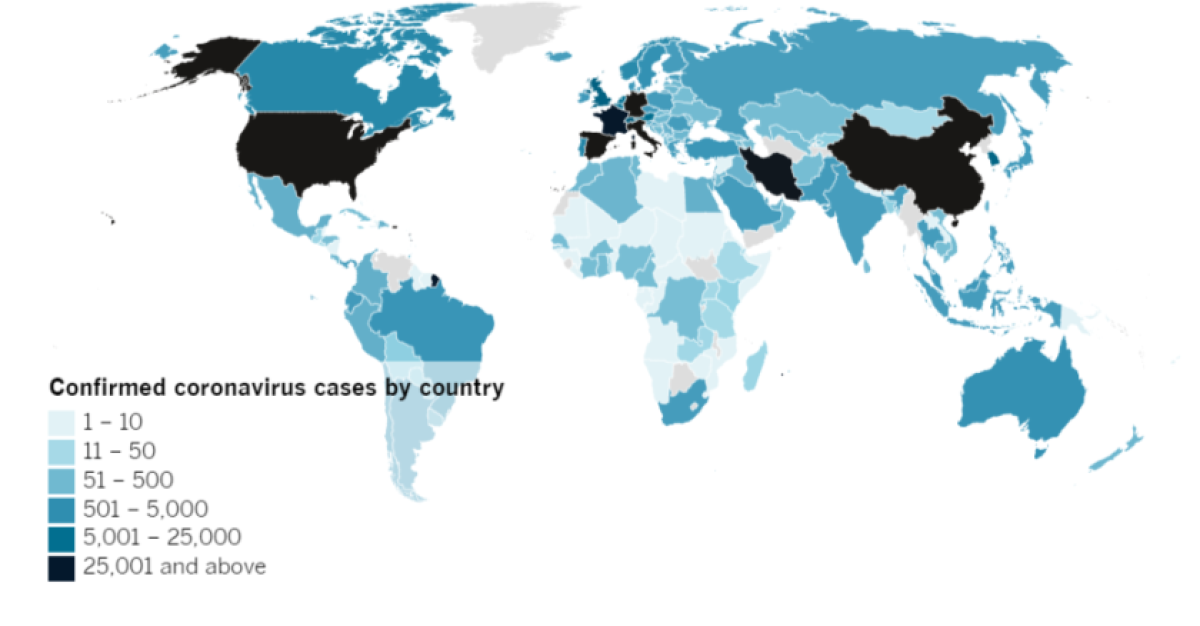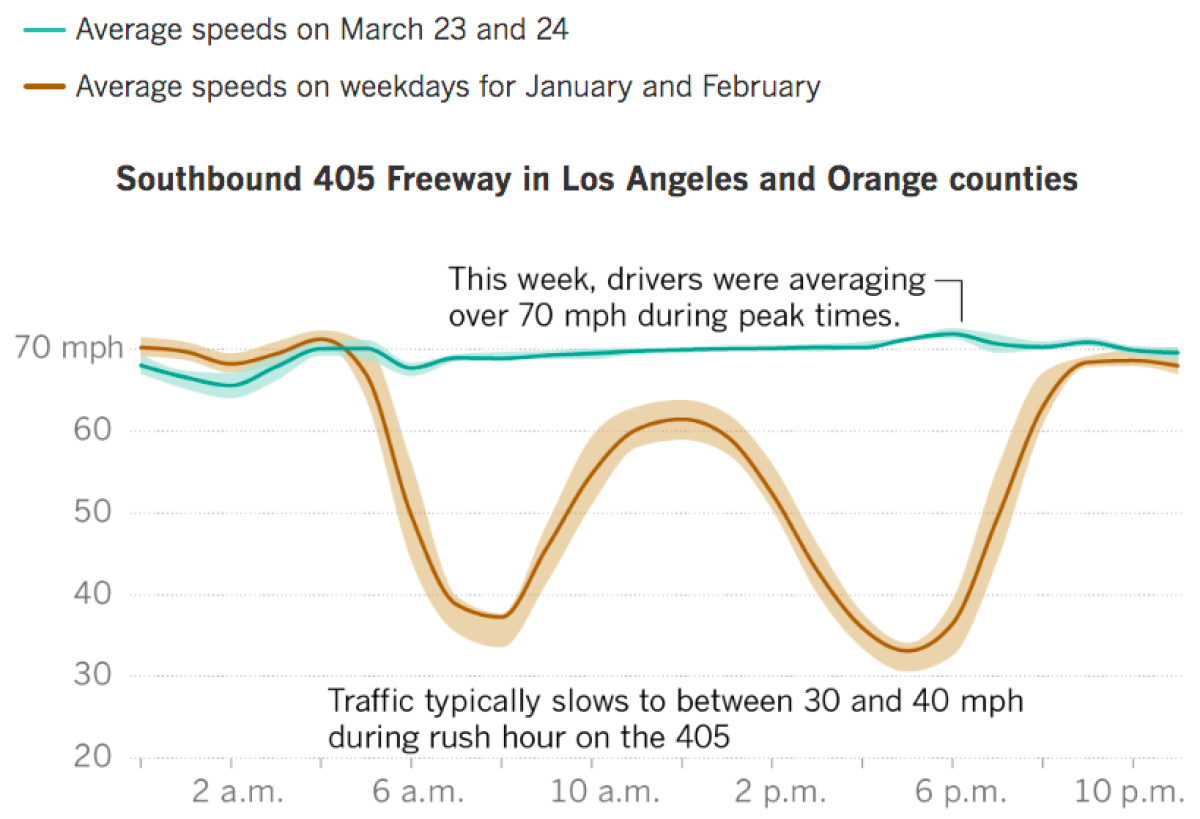Coronavirus Today: When will it peak?
- Share via
Good evening. I’m Diya Chacko, and it’s Thursday, March 26. Here’s what’s happening with the coronavirus outbreak, as the number of confirmed cases dramatically rises in California and beyond.
The U.S. has overtaken Italy and China as the country with the most confirmed cases, and California is seeing a major spike, including in Los Angeles County. So how much longer will confirmed cases and deaths keep exploding? Many of those people got sick before social-distancing rules were imposed statewide, and L.A. County officials hope such measures now underway will eventually slow the growth. But they also say Californians should brace for far more cases and deaths.
“If there are 1,000 people who are positive and each one of those people infects two other people ... within a few weeks, there could be a million people infected in L.A. County,” said Barbara Ferrer, county health director.
Doctors are contemplating the difficult choices they may be forced to make as the number of COVID-19 patients grows. Across the U.S., there could be as many as 31 patients requiring ventilation for every machine available, according to an article published this week in the New England Journal of Medicine. The shortage could be just as severe in California, where there are about 9,500 ventilators total statewide.
“You have an 80-year-old and a 20-year-old, and both need a vent, and you only have one. What do you do?” said a chief of emergency medicine at a San Francisco hospital. “There’s not a black-and-white answer.”
Car makers are trying to boost production of ventilators, apparel companies are sewing protective masks and distilleries are cranking out hand sanitizer. But with so much left to do, the federal government is being urged to use a Korean War-era law to order companies to ramp up production of critical supplies. The Defense Production Act gives the government the authority to buy and distribute equipment before other buyers, and even to order companies to produce goods on an emergency basis. So far the Trump administration, under pressure from business interests, has resisted invoking it.
People nationwide are scouring their homes for any gear that can be used to help doctors and nurses cope with a shortage of personal protective equipment, checking their garages, closets and earthquake kits for N95 masks, gowns and even hazmat suits to send to hospitals. If you have supplies to donate, visit masksfordocs.com.
Meanwhile, the $2-trillion economic stimulus package poised to be approved by Congress this week would provide direct payments to many American adults in as little as three weeks for those who already receive direct payments from the IRS. Checks will take longer. We have answers to some common questions about the payments, and some perspective on the scope of the new package. The package stands out not only for its record size but for giving employers unprecedented — and untested — incentives to keep people on their payrolls.
By the numbers
Cases as of 4 p.m. PDT Thursday:
Track the latest numbers and how they break down by county and by state with our graphics.
Where is the coronavirus spreading?

Your support helps us deliver the news that matters most.
Across California
Tenants and landlords throughout Southern California are bracing for next Wednesday, when April rents are due. State and local officials have provided limited protections to keep renters from being evicted and established some mortgage relief for landlords, but stress, fear and confusion remain. In Los Angeles County, 55% of residents are renters and rents are among the highest in the nation. Urged to act swiftly on protections for renters and workers suffering financially, the L.A. City Council will convene an emergency meeting Friday.
The L.A. Convention Center will be used to quarantine and isolate COVID-19 patients released from hospitals because they no longer need acute medical treatment but who could still be contagious, county public health officials said Thursday. Meanwhile, California nursing schools warn that about 10,000 students are in jeopardy of not graduating because hospital lockdown orders have interrupted their clinical education. That means they will be unable to help evaluate and treat patients.
Many essential workers who need childcare for their kids are relying on small-time operations — mostly women working in their homes with help from family members. But home-based daycare providers face a lack of coordinated emergency help, scarce state guidance and dwindling supplies to take care of children while preventing the spread of COVID-19.
Not even taco trucks, those icons of the L.A. culinary landscape, are being spared the economic fallout of the pandemic. With foot traffic and revenue drastically down, many of the city’s popular taco vendors are fighting for their livelihoods.
Between mass layoffs and work-from-home orders, the region’s traffic has evaporated and transit ridership plummeted, as our graphics show. On Thursday, the Metrolink commuter rail system slashed service after ridership plunged by 85%. Ridership has cratered in the Bay Area, too, and on Wednesday night, the Santa Clara Valley Transportation Authority suspended service immediately after a light rail operator trainee tested positive for the coronavirus.

How to stay safe
— Wash your hands for at least 20 seconds! Here’s a super-fun how-to video.
— Stop touching your face, and keep your phone clean.
— Watch for symptoms including fever, cough and shortness of breath (and possibly the loss of smell or taste), and if you’re worried you might be infected, call your doctor or urgent care clinic before going.
— Practice social distancing, such as maintaining a 6-foot radius of personal space in public.
— Only wear a mask if circumstances warrant it, for instance if you must be in very close contact with people in public.
— Here’s how to care for someone with COVID-19, from monitoring their symptoms to preventing the virus’ spread.
How to stay sane
— Was your job affected by coronavirus? Here’s how to file for unemployment.
— Here are all the ways to stay virtually connected with your friends.
— Need groceries? Here’s how to stock up for staying home. You can also watch our video guide on YouTube.
— Visit our free games and puzzles page for daily crosswords, card games, arcade games and more.
— Here are some free resources for restaurant workers and entertainment industry professionals having trouble making ends meet.
— Advice for helping kids navigate pandemic life includes being honest about uncertainties, acknowledging their feelings and sticking to a routine. Here’s guidance from the CDC.
— The L.A. Times Book Club will meet virtually beginning Monday and chat with L.A. noir authors. For more information, sign up for its newsletter.
Around the nation and the world
Until now, the U.S. has experienced COVID-19 mostly through the lens of metropolitan areas: Seattle, San Francisco, Los Angeles, New York. But as the virus spreads into small towns and rural areas, significant numbers of Americans keep dismissing calls for aggressive social distancing and shutdowns. Public health officials say such doubters seriously threaten efforts designed to reduce the virus’ spread and prevent mass casualties.
In China, a study of 33 pregnant women who were infected with the new coronavirus found that three of them gave birth to babies with COVID-19. All three infants cleared the virus within a week and survived, doctors reported Thursday. Although it’s not clear how the infection was passed from the mothers to the newborns, the study is a proof of the principle that transmission is possible, experts said.
The collapse of international travel has battered Mexico’s tourism industry, which generated $24.8 billion in 2019. Few places have been hit more forcefully than Cozumel, the renowned resort island that’s one of the world’s most-visited ports for cruise ships.
In Germany, sex work has long been legal, and often provides health insurance and pensions. But after Chancellor Angela Merkel announced last week that all brothels had to close, many in the business are scrambling to adjust. As one worker put it: “What we offer is a luxury article, not a daily need. This could be the first thing people cut back on.”
The first two days of India’s three-week lockdown — imposed by Prime Minister Narendra Modi with just four hours’ notice — have thrown the lives of some of the country’s poorest people into disarray. Stranded migrant workers are sleeping in city streets, police officers are beating curfew-breakers and masses of informal laborers are finding their livelihoods wiped out. For many, contracting the coronavirus is less urgent a concern than finding their next meal.
Your questions answered
Today’s reader question comes from Prather Smith, who wants to know: What does COVID-19 do to the lungs? Here’s what we know.
The new coronavirus, like most respiratory viruses, is spread by droplets from someone’s cough or sneeze. The vast majority of patients recover, usually after experiencing mild or moderate symptoms such as fever and cough. But sometimes the virus makes its way deep into the lungs and causes pneumonia.
Our lungs contain grape-like clusters of tiny air sacs called alveoli. When you breathe, oxygen fills the sacs and passes into blood vessels that nestle alongside them. Pneumonia occurs when an infection inflames the alveoli. In severe cases they fill with fluid, dead cells and other debris, preventing oxygen from getting through.
There is no cure for COVID-19. Supportive treatment centers around helping patients breathe when the oxygen levels in their blood start to drop. For some people, oxygen delivered through a mask or tubes in the nose is enough. More severely ill patients will need assistance from a ventilator.
The goal is to keep the person alive until the disease takes its course and the lungs begin to heal, doctors said.
Got a question? Our reporters covering the coronavirus outbreak want to hear from you. Email us your questions, and we’ll do our best to answer them. You can find answers to other common questions in our morning and midday roundup.
For the most up-to-date coronavirus coverage from The Times, visit our live updates page, visit our Health section and follow us on Twitter and on Instagram.





